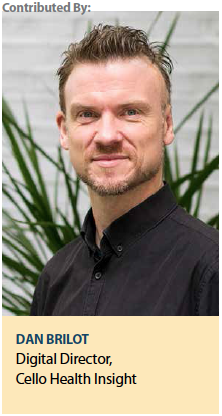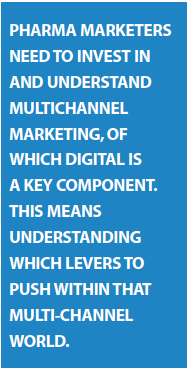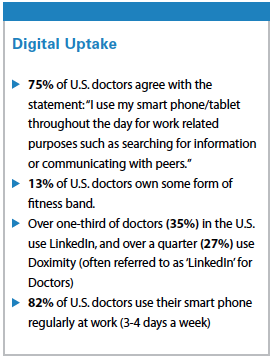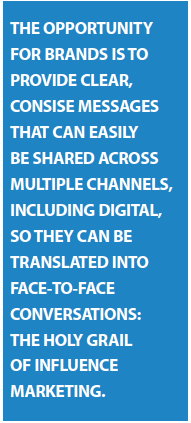No one in the pharma industry who is charged with building relationships with physicians should be surprised about the increasing need to engage  in the digital space with HCPs, and to provide clear, concise brand and product messages that can be easily shared across multiple channels.
in the digital space with HCPs, and to provide clear, concise brand and product messages that can be easily shared across multiple channels.
What might be more surprising is that doctors still put a huge weight on face-to-face interactions, presenting the big challenge of how to balance scarce marketing resources between digital and more traditional channels.
This was one of the key findings of a large piece of research — The Digital Health Debate — carried out by Cello Health Insight in late 2014 among doctors in the United States, United Kingdom, France, and Germany. The research found that although digital usage is on the increase, traditional sources are still the most trusted and, more importantly, have the highest ability to influence a prescribing decision.
Understanding how the various parts of a truly multichannel marketing mix interact is perhaps the biggest challenge facing the pharma market research world; the new digital channels represent a big opportunity, even if they are to a certain extent an unknown entity.
And/And, not Either/Or
Just as in the consumer marketing world, some digital advocates have been preaching that the future is almost exclusively online. A walk down any Main Street will show this is far from true; retail has been transformed by the Internet for sure, but customers in certain product categories (especially on higher ticket items) still want the reassurance of being able to physically interact with a brand (and the people who represent the values of that brand).
Even the digital colossus that is Apple puts great weight on their flagship stores (with well-trained and courteous staff); a pretty stable proportion of Netflix customers (6 million in the United States) still like to receive their films in the physical form of DVDs through the post.
It is a question not of either/or, but of and/and. Digital channels have a growing influence, but overall, peer influence, opinion leaders, event and conferences, and even rep visits all currently score higher as a trusted source of information than the highest-rating digital influencer (social media).
 While that balance may be slowly shifting, it seems certain that pharma will need to carry on investing in all of these channels for the foreseeable future. Human nature means that face-to-face will always be the most trusted way of communicating, and other channels such as digital are most useful when they are enabling conversations and “seeding" messages/content around the brand that will back up those more personal contacts.
While that balance may be slowly shifting, it seems certain that pharma will need to carry on investing in all of these channels for the foreseeable future. Human nature means that face-to-face will always be the most trusted way of communicating, and other channels such as digital are most useful when they are enabling conversations and “seeding" messages/content around the brand that will back up those more personal contacts.
Doctors trust tangible channels, which are predominantly face-to-face, and they trust the ones that are personal to them, such as interactions with their peers, or leaders in the field. What you might call non-personal channels are trusted less, and have a smaller influence on the prescribing decision — but they are still important in terms of reach, for example driving product or brand awareness.
These non-personal channels have traditionally included such things as advertising in medical journals, but increasingly it will also mean digital as well, even if there is still some way to go before this part of the mix has the same level of trust from, and influence on, doctors’ decision-making.
At the moment, there would appear to be a mismatch between HCPs’ acceptance of these new digital channels, and patients’ voracious appetite for new technologies that help them research, understand, and monitor their health. But this gap is closing fast, especially in the world of mobile technology.
The Doctor In The Pocket
One prediction is that 142 million health apps will be downloaded worldwide in 2016, so a shift in relationship between doctor and patient is inevitable; this doctor in your pocket will give patients 24/7 access to healthcare, and clinicians need to bite the bullet and influence which apps patients use and which they should avoid.
This is an excellent opportunity for pharma, too. We certainly shouldn’t be waiting for third party technology companies to design and develop these apps; pharma needs to be leading the way. What better way of increasing efficacy and offering greater value to HCPs in what has become known as “after the pill" services, than by developing compliance apps for their products?
This is already happening. Not only are new apps being developed by pharma brands every week, but those brands are putting far more thought into them, on the back of a deeper insight into how mobile technology is used.
In the past, there has been a tendency to make something mobile for the sake of it, but this is changing as pharma gets to grips with just how important the mobile platform is. We cannot ignore mobile any more, as it is the device of choice of many healthcare professionals.
This is particularly true in the United States, where doctors have a far greater ownership of technology devices than the general population; for example, 88% of American doctors own a smart phone, against 67% of the general population, and this is also true for other mobile devices such as tablets.
And it’s not just ownership: 82% of U.S. physicians say they use their smart phone regularly at work, for work purposes, and 75% agree with the statement “I use my smart phone or tablet throughout the day for work-related purposes such as searching for information or communicating with peers." Interestingly, this is far higher than in other markets: in the United Kingdom the figure is just 45%.
For market research professionals, another interesting statistic is that an overwhelming 87% of US physicians said they would be happy to take part in research via a mobile app.
These figures have big implications for pharma brands, including making sure that all websites are optimised for mobile and tablets. Consider also the sponsorship of smart phone or tablet apps as a campaign touch point, or indeed engaging via mobile when conducting business intelligence exercises.
Consumer or Specialist Channel?
The trend in social media over the past few years has been toward a diversification and specialization, with more sites becoming available that tap into specific needs, rather than simply being a space where everybody can talk to anybody.
into specific needs, rather than simply being a space where everybody can talk to anybody.
These sites have a specific function beyond the merely social: LinkedIn is perhaps the most successful, being used specifically for sharing information as well as general networking and, of course, looking for job opportunities.
In the United States especially, we have seen that specialization taken a stage further with the growth of Doximity — the so-called “LinkedIn for Doctors" — which now has 250,000 HCPs, and claims that 40% of all U.S. doctors are active users.
 Despite this, some two-thirds of U.S. doctors have used some form of general consumer media in the past month. These are channels that traditionally have been considered as places where pharma couldn’t — or indeed didn’t want to — play. But with a significant minority (one in 10) of HCPs using Facebook and Twitter on a monthly basis to receive and share information with peers, pharma cannot afford to ignore this space as part of a multichannel marketing strategy.
Despite this, some two-thirds of U.S. doctors have used some form of general consumer media in the past month. These are channels that traditionally have been considered as places where pharma couldn’t — or indeed didn’t want to — play. But with a significant minority (one in 10) of HCPs using Facebook and Twitter on a monthly basis to receive and share information with peers, pharma cannot afford to ignore this space as part of a multichannel marketing strategy.
And it’s not just physicians who are using these online spaces, patients are avid users too. WebMD, the most popular health site in the United States, has more than 80 million unique visitors a month, and 78% of U.S. doctors told us that many of their patients often look up their condition prior to a consultation. And 45% said many of their patients come to them with a named prescription, having diagnosed themselves online, a figure that is higher than in the United Kingdom (33%), and significantly greater than in other European markets such as France and Germany.
Pharma brands need to be aware of this, and take appropriate action. The opportunity is to provide platforms — via apps, for example — which fill blanks left by doctors, and that can help patients with compliant information and support for patients, and help facilitate better health outcomes.
Being Truly Multichannel
The challenge for pharmaceutical marketers is two-fold. First, they must understand the interplay between the elements that make up a truly multichannel marketing approach, including the importance of the traditional, face-to-face approach.
And then marketers must gain an insight into how digital channels are changing that balance, and where these emerging technologies will play a larger part in the marketing mix of the future.
The opportunity for brands is to provide clear, concise messages that can easily be shared across multiple channels, including digital, so that they can be translated into what remains the holy grail of influence marketing: those face-to-face conversations about the brand among peers, patients, and opinion leaders. (PV)
Editor’s Note: The complete Digital Health Debate report from Cello Health Insight can be downloaded for free from www.cellohealthinsight.com/digital-health-debate.
Cello Health Insight is the global marketing research arm of Cello Health, with offices in New York, Chicago, and London. Cello Health consists of three distinct capabilities: Cello Health Insight: global marketing research and customer insight; Cello Health Consulting: strategic consultancy; and Cello Health Communications: evidence and engagement.
For more information, visit cellohealth.com


















